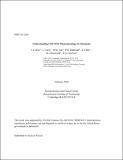| dc.contributor.author | Rice, John E. | en_US |
| dc.contributor.author | Citrin, J. | en_US |
| dc.contributor.author | Cao, N.M. | en_US |
| dc.contributor.author | Diamond, P.H. | en_US |
| dc.contributor.author | Fable, E. | en_US |
| dc.contributor.author | Greenwald, M. | en_US |
| dc.contributor.author | Grierson, B.A. | en_US |
| dc.date.accessioned | 2025-03-21T20:11:08Z | |
| dc.date.available | 2025-03-21T20:11:08Z | |
| dc.date.issued | 2020- 02 | |
| dc.identifier | 20ja006 | |
| dc.identifier.uri | https://hdl.handle.net/1721.1/158554 | |
| dc.description | Submitted for publication in Nuclear Fusion | |
| dc.description.abstract | Phenomenology of Ohmic energy confinement saturation in tokamaks is reviewed. Characteristics of the linear Ohmic confinement (LOC) and saturated Ohmic confinement (SOC) regimes are documented and transformations in all transport channels across the LOC/SOC transition are described, including rotation reversals, ``non-local'' cut-off and density peaking, in addition to dramatic changes in fluctuation intensity. Unification of results from nearly 20 devices indicates that the LOC/SOC transition occurs at a critical value of the product of the density, edge safety factor and device major radius, and that this product increases with toroidal magnetic field. Comparison with gyro-kinetic simulations suggests that the effects of sub-dominant TEMs are important in the LOC regime while ITG mode turbulence dominates with SOC. | |
| dc.publisher | IOP | en_US |
| dc.relation.isversionof | doi.org/10.1088/1741-4326/abac4b | |
| dc.source | Plasma Science and Fusion Center | en_US |
| dc.title | Understanding LOC/SOC Phenomenology in Tokamaks | en_US |
| dc.type | Article | en_US |
| dc.contributor.department | Massachusetts Institute of Technology. Plasma Science and Fusion Center | |
| dc.relation.journal | Nuclear Fusion | |
